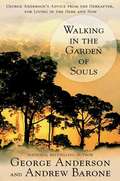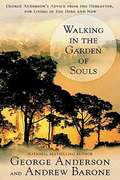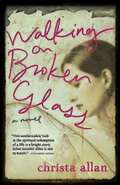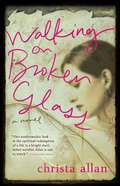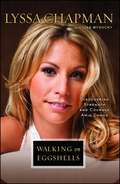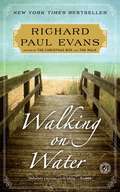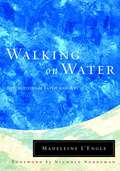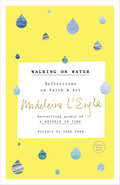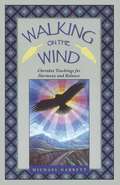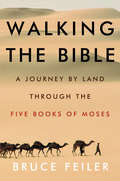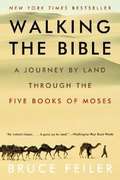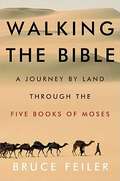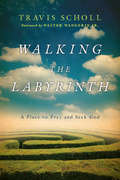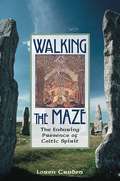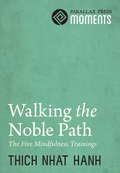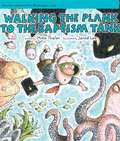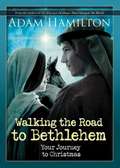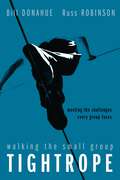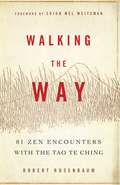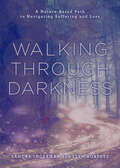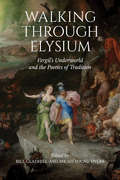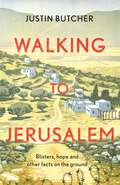- Table View
- List View
Walking in the Garden of Souls
by George Anderson Andrew BaroneGeorge Anderson says he has messages from the other side or the light which those who have left the earth wish communicated. Through transcripts of sessions he has held with family members and friends of the departed, he discusses life after death, the goals we should be pursuing here, and reassures us our loved ones still exist.
Walking in the Garden of Souls: George Anderson's Advice From The Hereafter For Living In The Here And Now
by George Anderson Andrew BaroneFor 27 years, George Anderson, widely considered the world's greatest living medium, has listened to those on the other side, gaining a unique awareness of what those souls want his millions of believers to know, to understand, and to accept. Now Anderson shares this wisdom-and offers an incomparable perspective on the questions faced in day-to-day life.
Walking on Broken Glass
by Christa AllanLeah Thornton's life, like her Southern Living home, has great curb appeal. But a paralyzing encounter with a can of frozen apple juice in the supermarket shatters the façade, forcing her to admit that all is not as it appears. When her best friend gets in Leah's face about her refusal to deal with her life and her drinking, Leah is forced to make a decision. Can this brand-conscious socialite walk away from the country club into 28 days of rehab? Can she leave what she has now to gain back what she needs? Joy, sadness, pain and a new strength converge, testing her marriage, her friendships and her faith.
Walking on Broken Glass
by Christa AllanLeah Thornton's life, like her Southern Living home, has great curb appeal. But a paralyzing encounter with a can of frozen apple juice in the supermarket shatters the façade, forcing her to admit that all is not as it appears. When her best friend gets in Leah's face about her refusal to deal with her life and her drinking, Leah is forced to make a decision. Can this brand-conscious socialite walk away from the country club into 28 days of rehab? Can she leave what she has now to gain back what she needs? Joy, sadness, pain and a new strength converge, testing her marriage, her friendships and her faith.
Walking on Eggshells: Discovering Strength and Courage Amid Chaos
by Lyssa ChapmanAn empowering memoir that can inspire others to break the cycle of abuse and forge happiness out of extreme adversity.The ninth child of bounty hunter Duane Chapman, made famous on the A&E show Dog the Bounty Hunter, Lyssa Chapman has overcome an upbringing that can only be called tragic. In her piercing memoir, she shares the details of her harrowing childhood and her journey to faith, and offers compassionate guidance, advice, and hope to those who might feel overwhelmed in their own circumstances. As a child, Baby Lyssa&’s parents divorced and left her neglected. Things only got worse from there. Walking on Eggshells reveals Lyssa&’s nightmare passage from mental and physical abuse to removal from school and confinement at home, flight from protective services, and teen pregnancy. Despite it all, and against incredible odds, Lyssa found her faith. She also found her way out of the spiral of bad decisions to build a healthy relationship with her parents and forge a rewarding, positive life with God. An astonishing true story of one young woman&’s trek from poverty and abuse to fulfillment and stardom, Walking on Eggshells is heartrending, powerful, and inspiring.
Walking on Water: A Novel (The Walk Series #5)
by Richard Paul EvansWith this New York Times bestseller, the beloved Walk series ends as Alan Christoffersen reaches his destination and the beginning of a new life: “Definitely a journey worth taking” (Booklist).After the death of his beloved wife, after the loss of his advertising business to his once-trusted partner, after bankruptcy forced him from his home, Alan Christoffersen embarked on a daring cross-country journey—a walk across America, from Seattle to Key West, with only the pack on his back. Through it all he learned life-changing lessons about love, forgiveness, and most of all, hope. Now Alan must again return west to face yet another crisis, one that threatens to upend his world just as he had begun to heal from so much loss, leaving him unsure of whether he can reach the end his journey. It will take the love of a new friend, and the wisdom of an old friend, to help him to finally leave the past behind and find the strength and hope to live again. Walking on Water is a beautiful story of one man’s search for a new beginning, of “humorous moments, heartwarming moments, moments of self-discovery, and moments of profound wisdom” (Deseret Morning News).
Walking on Water: Reflections on Faith and Art
by Madeleine L'EngleIn this classic book, Madeleine L'Engle addresses the questions: What makes art Christian? What does it mean to be a Christian artist? What is the relationship between faith and art? Through L'Engle's beautiful and insightful essay, readers will find themselves called to what the author views as the prime tasks of an artist: to listen, to remain aware, and to respond to creation through one's own art.
Walking on Water: Reflections on Faith and Art
by Madeleine L'Engle Sara ZarrIn this classic book, Madeleine L'Engle addresses the questions, What makes art Christian? What does it mean to be a Christian artist? What is the relationship between faith and art? Through L'Engle's beautiful and insightful essay, readers will find themselves called to what the author views as the prime tasks of an artist: to listen, to remain aware, and to respond to creation through one's own art.
Walking on the Wind: Cherokee Teachings for Harmony and Balance
by Michael Tlanusta GarrettIn the spirit of the highly acclaimed Medicine of the Cherokee, coauthored with his father J. T. Garrett, Michael Garrett shares with us the delightful, all-ages stories passed down from his great-grandfather and other medicine teachers. Blending his background as an Eastern Cherokee with his skills as a counselor, Michael reveals through these tales how to make sense of our experiences in life, see beauty in them, and be at peace with our choices. "Michael's blend of traditional Cherokee ways with that of science and psychology illustrates that both Native and non-Native peoples can learn to thrive together...for the betterment of all" --Native Peoples magazine
Walking the Bible
by Bruce FeilerBoth a heart-racing adventure and an uplifting quest, Walking the Bible describes one man's epic odyssey--by foot, jeep, rowboat, and camel--through the greatest stories ever told. From crossing the Red Sea to climbing Mount Sinai to touching the burning bush, Bruce Feiler's inspiring journey will forever change your view of some of history's most storied events.
Walking the Bible: A Journey by Land Through the Five Books of Moses
by Bruce FeilerOne part adventure story, one part archaeological detective work, one part spiritual exploration, Walking The Bible vividly recounts an inspiring personal odyssey -- by foot, jeep, rowboat, and camel -- through the greatest stories ever told. Feeling a desire to reconnect to the Bible, award-winning author Bruce Feiler set out on a perilous, 10,000-mile journey retracing the Five Books of Moses through the desert. Traveling over three continents, through five countries, and four war zones, Feiler is the first person to complete such a historic expedition. He crosses the Red Sea, climbs Mt. Sinai, and interviews bedouin and pilgrims alike, as he attempts to answer the question: Is the Bible just an abstraction, or is it a living, breathing entity? Both a pulse-pounding adventure and an uplifting spiritual quest, Bruce Feiler's Walking the Bible is a stunning and elevating work of courage, scholarship, and heart that revisits the inscrutable desert landscape where the world's great religions were born -- and uncovers fresh answers to the most profound questions of the human spirit.
Walking the Bible: A Journey by Land Through the Five Books of Moses
by Bruce Feiler"The process of gathering these images reminded me of the Bible's effortless ability to reinvent itself for each generation and each new way of searching." -Bruce Feiler Its stories may be the best known in the world, but its locations have long been a mystery. Where did Noah's ark land? Where did Moses receive the Ten Commandments? Where are the lost cities of Sodom and Gomorrah? Now, in Walking the Bible: A Photographic Journey, New York Times bestselling author Bruce Feiler offers an unprecedented heart-stirring adventure through the landscape of some of history's most storied events. Featuring Bruce Feiler's own photography as well as his selections from professional collections, Walking the Bible: A Photographic Journey brings together breathtaking vistas, intimate portraits, and fascinating panoramas, providing firsthand access to the inscrutable land where three of the world's great religions were born-and finally puts a face on the stories that have long inspired the human spirit. Over several years, Feiler traveled nearly ten thousand miles through the deserts of the Middle East, which led first to his runaway national bestseller Walking the Bible. This new illustrated book follows his route, offering a thrilling photographic voyage through the actual places of some of the Bible's most memorable events-from the heights of Mount Ararat, where Noah's ark landed, to the desert outpost in Turkey, where Abraham first heard the words of God, to the summit where Moses overlooked the Promised Land. Walking the Bible: A Photographic Journey chronicles a landscape that nurtured the relationship between humans and the divine, breathing new meaning into stories that have been a timeless source of inspiration.
Walking the Dog
by Gail SattlerThis is a humorous Christian romance between a dog trainer and one of her clients.
Walking the Labyrinth: A Place to Pray and Seek God
by Travis SchollOne day Travis Scholl discovered a labyrinth in his neighborhood. As he began to walk it, he found this ancient practice offered a much-needed path away from life's demands, allowing him to encounter God in quiet solitude. In this meditative guide, Travis Scholl takes readers on a journey: "The path is always new, because, as a spiritual discipline, the labyrinth is a tool for contemplation, for reflection, for prayer. Underneath the surface, walking the labyrinth is a profound exercise in listening, in active silence, in finding movement and rhythm in the stillnesses underneath and in between every day?s noise. Walking the labyrinth is an exercise in finding the voice speaking in whispers underneath the whirlwind of sound." With no end, but only a center, labyrinths become a physical symbol of prayer and our journey with God. Each step unites faith and action as travelers take one step at a time, living each moment in trust and willingness to follow the course set before them. Providing a historical and modern context for this unique spiritual discipline, Scholl weaves his own journey through a labyrinth with the Gospel of Mark's telling of the twists and turns of Jesus' life, providing 40 reflections ideal for daily reading during Lent or any time of the year.
Walking the Maze: The Enduring Presence of Celtic Spirit
by Loren CrudenA vivid description of the fierce and free Celtic spirit as it has been sustained through history, and a vision for living that spirit in the present • Equates Celtic customs with Native American traditions and rituals • Presents a vision of the ancient Celtic path as it can be lived today With the perspective of a passionate historian and the clarity of a modern-day medicine woman, Loren Cruden presents to us a vision of ancient Celtic spirit as it can be lived today. In Walking the Maze she explores Celtic culture both in comparison to Native American ways of life and in its own light and strength, examining the attributes that define and sustain the vitality of the Celtic spirit. Four aspects of traditional Celtic life common to both Celtic and Native American cultures are kinship consciousness, a high regard for women as part of a general commitment to freedom, a fluid perspective of reality, and a primal spiritual engagement with the land. For the Celts this crafted rugged, land-loving individualists, fierce and free in their expression, gracious to all, answerable directly to Spirit but responsible for the entire community. This vision of Celtic spirit informs the vision of how we may live in the present, renewing a cultural integrity that is inseparable from personal wholeness and ecological consciousness.
Walking the Noble Path
by Thich Nhat HanhZen Master Thich Nhat Hanh presents the true path to a personal and global ethic in this stand alone chapter of Good Citizens: Creating Enlightened Society.
Walking the Plank to the Baptism Tank
by Mike ThalerWith hilarious stories and nutty pictures, the Tales from the Back Pew series offers kids a unique view of church. Enjoy plenty of giggles with your child — and learn fun, important truths about God, church, and the Bible. Walking the Plank to the Baptism Tank I’m getting baptized this Sunday, but I can’t swim! Pastor says not to worry because God is my lifeguard. I sure hope he’s on duty. With unique humor, Mike Thaler turns common church activities into fun and valuable time. He keeps kids laughing while introducing them to the love of God and encouraging them in their faith.
Walking the Road to Bethlehem: Your Journey to Christmas (The\journey Ser.)
by Adam HamiltonBased on Hamilton's, The Journey: Reflections for the Season, this new edition contains added content to create an experience of preparation of heart and mind for Christmas. Experience the Nativity story in new ways as you take your own journey to Christmas. Walking the Road to Bethlehem combines content from Adam’s travel from Nazareth to Bethlehem, a summary of the historical and scriptural content from each chapter of The Journey, links to travel video and photographs online, Scripture, prayers and room for personal journaling. Walking the Road to Bethlehem is excellent for individual devotion and reflection and can also be used as a small group experience.
Walking the Small Group Tightrope: Meeting the Challenges Every Group Faces
by Bill Donahue Russ RobinsonAt last there is a proven resource from Willow Creek created specifically for small group leaders, those who serve in the trenches of small group life and ministry.
Walking the Way
by Robert Rosenbaum Sojun Mel WeitsmanWalking the Way affirms that, like yin and yang, the flowing spontaneity of Tao and the precise simplicity of Zen find perfect balance with one another. Robert Meikyo Rosenbaum brings the two traditions together in a unique presentation that elicits Zen insights from his fresh interpretation of verses from the Taoist classic, the Tao Te Ching. Personal anecdotes illustrate the dynamic potential of Rosenbaum's approach, skillfully revealing Zen within the Tao and the Tao of Zen. Not only does the author reveal the elegance of each tradition, he shows how their interrelatedness does, in fact, have import on our meditative practices and on our day-to-day lives. Parenting, meditating, dealing with setbacks and illnesses--Walking the Way shows us how to live well in the midst of many complex demands, finding harmony and equilibrium between honing in and letting go, balance between being ourselves and selflessly serving others.
Walking through Darkness: A Nature-Based Path to Navigating Suffering and Loss
by Sandra Ingerman Llyn RobertsMay the teachings in this book help you walk wakefully as you find your way back home. Every one of us experiences periods of pain and loss in our life—dark nights of the soul. This is a groundless territory where one feels directionless and devoid of tools, with no sense of how to take the next step. In ancient times, elders guided their communities through life&’s initiations and challenges, paths we must all take to transform and grow. In Walking through Darkness, legendary shamanic experts Sandra Ingerman and Llyn Roberts help us forge a pathway through the dark—as we embrace nature as our guide and healer. Sandra and Llyn share metaphorical stories that engage animals, plants, trees, and other aspects of nature. Through the feminine process of circular joint storytelling, they weave the rich tales of their own experiences alongside wisdom that they have gathered for years from their own studies, as well as from healers around the globe. Through teachings from the land, the sky, the sea, and the spiritual world, this sensitive and empowering guide opens us to our spiritual light so that we can face our greatest challenges with courage and love—no matter what they are.
Walking through Elysium: Vergil’s Underworld and the Poetics of Tradition (Phoenix Supplementary Volumes)
Walking through Elysium stresses the subtle and intricate ways writers across time and space wove Vergil’s underworld in Aeneid 6 into their works. These allusions operate on many levels, from the literary and political to the religious and spiritual. Aeneid 6 reshaped prior philosophical, religious, and poetic traditions of underworld descents, while offering a universalizing account of the spiritual that could accommodate prior as well as emerging religious and philosophical systems. Vergil’s underworld became an archetype, a model flexible enough to be employed across genres, and periods, and among differing cultural and religious contexts. The essays in this volume speak to Vergil’s incorporation of and influence on literary representations of underworlds, souls, afterlives, prophecies, journeys, and spaces, from sacred and profane to wild and civilized, tracing the impact of Vergil’s underworld on authors such as Ovid, Seneca, Statius, Augustine, and Shelley, from Pagan and Christian traditions through Romantic and Spiritualist readings. Walking through Elysium asserts the deep and lasting influence of Vergil’s underworld from the moment of its publication to the present day.
Walking to Jerusalem: Blisters, hope and other facts on the ground
by Justin Butcher'What's so impressive about Justin Butcher's book is the interweaving of his personal face-to-face experiences in Israel and Palestine against the backdrop of the social and political realities there. This book displays an empathy that is unusual in discussions of that tangled and tragic situation - the kind of empathy that will be essential in arriving at any decent solution to it.' BRIAN ENO 2017 marked three important anniversaries for the Palestinian people: 100 years since the Balfour Declaration; 50 years since the Six-day War; and ten years since the Blockade of Gaza. As an act of penance, solidarity and hope, actor and musician Justin Butcher - along with ten other companions for the full route, plus another hundred joining him for various stretches along the way - walked from London to Jerusalem. This book is the record of his journey: a combination of walking journal, travel writing and pilgrim stories. It's less of a travel guide to walking across Europe and more an exploration of the many strands radiating from the Holy Land and its narrative, weaving paths across place and history, through the lives of Justin's fellow-walkers - and, of course, his own life. Between the route itinerary and the themes of Balfour and Christian Zionism, Weizmann and cordite, colonialism, Jerusalem Syndrome and Desert spirituality, Justin charts a chronicle of serendipity: happenstances hilarious, infuriating and occasionally numinous - or, as pilgrims might say, encounters with the Divine.'This is a gripping and intelligent book that everybody should read.' PATRICK COCKBURN, Middle East correspondent, The Independent
Walking to Jerusalem: Blisters, hope and other facts on the ground
by Justin Butcher2017 marked three important anniversaries for the Palestinian people: 100 years since the Balfour Declaration; 50 years since the Six-day War; and ten years since the Blockade of Gaza. As an act of penance, solidarity and hope, actor and musician Justin Butcher - along with ten other companions for the full route, plus another hundred joining him for various stretches along the way - walked from London to Jerusalem. This book is the record of his journey: a combination of walking journal, travel writing and pilgrim stories. It's less of a travel guide to walking across Europe and more an exploration of the many strands radiating from the Holy Land and its narrative, weaving paths across place and history, through the lives of Justin's fellow-walkers - and, of course, his own life. Between the route itinerary and the themes of Balfour and Christian Zionism, Weizmann and cordite, colonialism, Jerusalem Syndrome and Desert spirituality, Justin charts a chronicle of serendipity: happenstances hilarious, infuriating and occasionally numinous - or, as pilgrims might say, encounters with the Divine.
Walking to Jerusalem: Blisters, hope and other facts on the ground
by Justin Butcher2017 marked three important anniversaries for the Palestinian people: 100 years since the Balfour Declaration; 50 years since the Six-day War; and ten years since the Blockade of Gaza. As an act of penance, solidarity and hope, actor and musician Justin Butcher - along with ten other companions for the full route, plus another hundred joining him for various stretches along the way - walked from London to Jerusalem. This book is the record of his journey: a combination of walking journal, travel writing and pilgrim stories. It's less of a travel guide to walking across Europe and more an exploration of the many strands radiating from the Holy Land and its narrative, weaving paths across place and history, through the lives of Justin's fellow-walkers - and, of course, his own life. Between the route itinerary and the themes of Balfour and Christian Zionism, Weizmann and cordite, colonialism, Jerusalem Syndrome and Desert spirituality, Justin charts a chronicle of serendipity: happenstances hilarious, infuriating and occasionally numinous - or, as pilgrims might say, encounters with the Divine.
